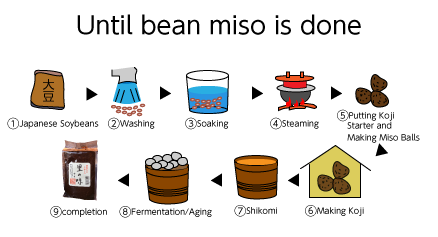MameMiso
The most important part of the process of making Miso is to make “Koji”. First the soybeans are mixed with “Koji” fungus and kept at 30 degree Celsius, with good air circulation, to incubate for three days.
At “Minamigura”, “Shikomi of Miso” (fermenting soybean) is still only done once a year, from the end of February until April. The quantity of salt water is decided by analyzing the condition of “Koji” thus controlling the saltiness accurately. “Shikomi” is the process of putting the “Koji” and a salt solution in a huge Japanese cedar wood vat that is over a hundred years old and taller than a man. The mixture is then pressed and the whole process is repeated many times. Then it is kept for three years to ferment and age.
Large industrial companies use the Warmed Brewing (Short Period Brew) which keeps the “Koji” at 30 degree Celsius all year round to artificially speed up the fermentation. This process cost less and is more profitable but lacks the strong subtle taste because of the lack of aging.
“Mame Miso” made by natural brewing achieves its characteristic and strong taste, by its long exposure to the Japanese wet hot summers and dry cold winters. “Mame Miso” is never heated during the entire process, therefore its flavor and enzymes remain alive.

